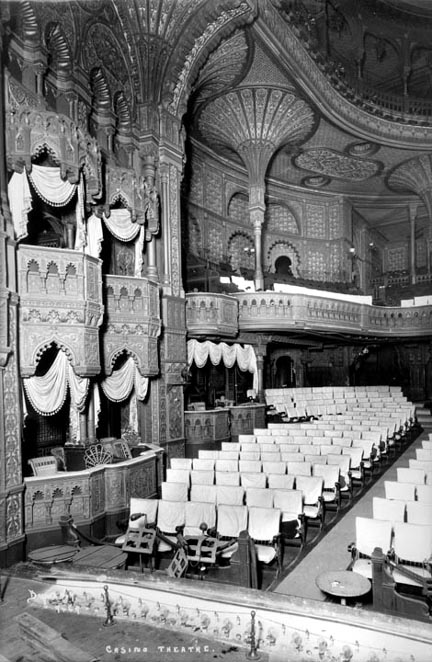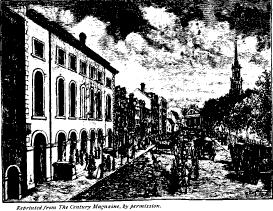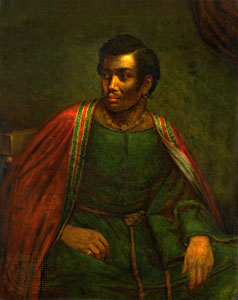
|
African Grove Theater |

|

|
African Grove Theater |

|
The lecture will also discuss the arrival of African Americans in the United States and the lifestyles that determined their daily activities.
Nineteenth Century Theater in the United States William Alexander Brown and "The Grove" Stephen Price and The Park Theater Ira Aldridge and The Black Doctor |
Free Blacks in the north generally worked as domestic servants or in subsistence farming. There were some who worked as skilled artisans in trades such as blacksmithing or carpentry. Some free blacks also worked on the docks and in the shipping industry loading and unloading boats. The two men who founded the African Grove Theater, William Henry Brown and James Hewlett, were stewards who worked on ships. Through their work, they were able to travel back and forth between England, New York, and the Caribbean and to see theatrical productions.
STEWARD an employee on a ship who distributes food and attends to the passengers.
Both Hewlett and Brown were based in New York City where life was hard and Black and White communities were segregated. Free Blacks were excluded from public schools, prohibited form interstate travel, barred from voting in many states, and harassed by hostile White mobs. As a result, African Americans formed their own institutions and organizations to support their lifestyles. For example, the African Free School opened its doors in New York City in 1787 and educated African Americans for fifty years. In the early nineteenth century and for most of the twentieth century there were also separate African American churches, newspapers, and civic organizations.
![]()
Eighteenth Century Theater in the United States

|
|
Established in 1882
|
The
earliest theatre companies to perform in America were from England and
toured the Colonies. It was not until 1767 that the first independent American
acting
company played in New York at the John Street Theater. During the late 18the century, Philadelphia, Boston, and New York were the theatrical centers.
Most theatrical entertainments featured star performers who presented short dramatic excerpts from Shakespeare¹s plays. Melodramas with spectacular scenic effects were
also popular however the elaborate stage props were very difficult to transport and inappropriate for touring in the colonies.
By 1815, the United States was beginning to produce its own actors in addition to employing touring British stars. Some of the most well known performers around 1821 (when the African Grove Theater was active) were William Macready, Charles Matthews, and Edmund Kean.
The Park Theater of New York, under the leadership of Stephen Price, was one of the most influential houses for presenting British stars in the United States.

|
|
Established in 1882
|
Inspired by Hewlett, Brown constructed a theater on Mercer Street and hired a company of Black performers to present plays to African American audiences. Performances there became a novelty and eventually attracted a White clientele who came to gawk at the Black actors imitating European nobles.
The most popular plays at the African Grove were Richard III and Othello, but original works were also presented. King Shotaway, a play about a Black Carib revolt on the island of St Vincents was written by William Brown and was the first African American play to be written and produced in the Untied States. No extant copy of this script remains.
The actors took great liberties with the play texts and added songs and dances to the original material as they deemed fit. One critic described an 1821 production as follows:
Apparently the intent of the production was to present the juiciest excerpts of the dramatic literature. Odell also writes that the neighbors complained of the noise and that the entrance door to the theater had to be closed....Negroes resolved to get up a play, and used the upper apartments of the African Grove for a performance of Richard III. A dapper, wooly haired waiter at the City Hotel personated the royal Plantagenet in robes made up from discarded merino curtains of the ballroom. Owing to the smallness of the company King Henry and the Dutchess were played by one person, and Lady Anne and Catesby by anotherÉLady Anne, in Act III, sang quite incongruously. (Odell, George. National Advocate, 21 September, 1821)
"The African Grove Theatre and Company had to be mobile when they started doing plays because the police were constantly raiding their performances and pressuring them to stop performing, due to the rowdiness of the white members of the audience. William Over states that the whites had initially found it curious and amusing that a company of black actors was attempting to do Shakespeare, but that they later became very hostile. The African Theatre attempted to remedy the situation by creating a partitioned area for whites at the back of the theatre, but the hostile whites continued to create disturbances which eventually closed the theater." (Dewberry, Jonathan. "The African Grove Theatre and Company," Black American Literature Forum v.16 [1982] pp.129)
The company moved from Brown¹s home at 38 Thompson Street, uptown to the Pantheon Theater on Mercer Street between Bleecker and Prince, to Houston and Mercer near the Park Theater, to One Mile Stone on Broadway between Mercer and Prince, and finally to a rural site north of 14th Street.
One of the most interesting stories about the African Grove is the rivalry that existed between this small theater and Stephen Price¹s Park Theater. When ousted from the house on Thomas Street, Brown rented a hall right next to the Park Theater for performance of Richard III that coincided with the Park Theater¹s presentation of the same play. Stephen Price hired a mob to stage a "riot" and had the police shut down the African Grove performances.
No one really knows why the African Grove folded. Brown also declared bankruptcy when he was unable to pay his debts. There was also a small pox epidemic in 1822 that may have affected audiences who were afraid to venture into the rural 14th street neighborhood. There are no records of the African Grove Theater after 1823; however, the company, during the time of its existence, was an important medium for African Americans to perform dignified roles for a cross section of Black and White audiences.

|
|
|
One important actor, Ira Aldridge, was nurtured in the African Grove and went on to international success. For class we will be reading his melodramatic play The Black Doctor.
Ira Aldridge was born as a freeman in the United States. He was the son of a Calvinist minister and he attended the African Free School in New York City. In 1824, after participating in a few of the performances at the African Grove Theater, he left for Europe where he achieved great success as a touring actor. He studied at the University of Glasglow and performed at theaters in London, Scotland, Ireland, Paris, and Poland. He received the Prussian Gold Medal for Arts and Science, and once replaced the great actor Edmund Kean in the role of Othello when Kean fell ill. Aldridge was frequently compared with the Roman actor Roscius; he called himself "the African Roscius" in publicity flyers and proclaimed himself to be a native of Senegal. He died in Lodz, Poland at the age of sixty.
The Black Doctor was a star vehicle for Aldridge and he played the leading role. It is an adaptation of a French play about a doctor whose romantic love is unattainable. The play features a variety of character "types." As with most melodramas, the settings are spectacular and the lead actors move quickly form indoor to outdoor panoramas. Note how the settings change to depict the class and stature of the characters.
1) Why do you think that the actors of the African Grove Theater chose to perform Shakespearean roles?2) What purpose did theater serve for the 18th century residents of the United States?
3) What types of roles would Ira Aldridge have played had he remained in the United States
4) What are the social implications of Fabian¹s love of Pauline in the play? How would this love affair have been perceived differently in Europe and the United States?
|
[Home]
|
Copyrighted
2001, United States
of America
Anita Gonzalez & Ian Granick